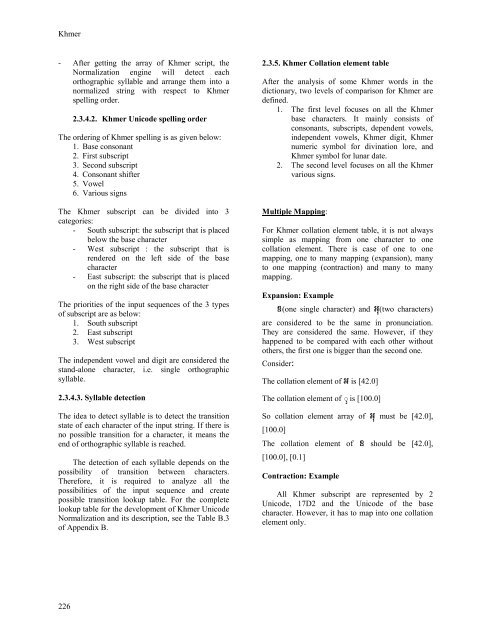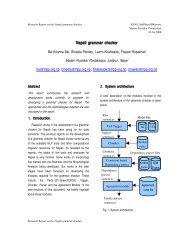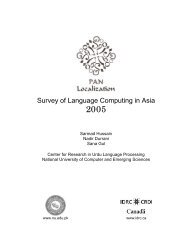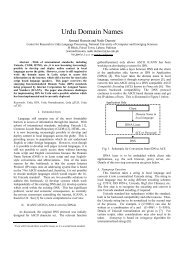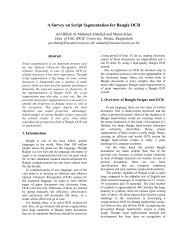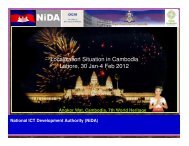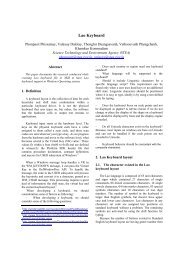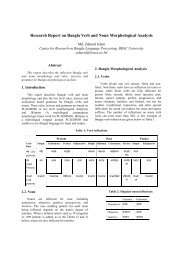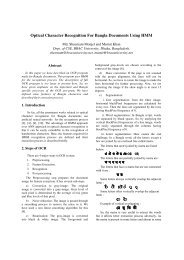Khmer Collation Development - PAN Localization
Khmer Collation Development - PAN Localization
Khmer Collation Development - PAN Localization
Create successful ePaper yourself
Turn your PDF publications into a flip-book with our unique Google optimized e-Paper software.
<strong>Khmer</strong><br />
- After getting the array of <strong>Khmer</strong> script, the<br />
Normalization engine will detect each<br />
orthographic syllable and arrange them into a<br />
normalized string with respect to <strong>Khmer</strong><br />
spelling order.<br />
2.3.4.2. <strong>Khmer</strong> Unicode spelling order<br />
The ordering of <strong>Khmer</strong> spelling is as given below:<br />
1. Base consonant<br />
2. First subscript<br />
3. Second subscript<br />
4. Consonant shifter<br />
5. Vowel<br />
6. Various signs<br />
The <strong>Khmer</strong> subscript can be divided into 3<br />
categories:<br />
- South subscript: the subscript that is placed<br />
below the base character<br />
- West subscript : the subscript that is<br />
rendered on the left side of the base<br />
character<br />
- East subscript: the subscript that is placed<br />
on the right side of the base character<br />
The priorities of the input sequences of the 3 types<br />
of subscript are as below:<br />
1. South subscript<br />
2. East subscript<br />
3. West subscript<br />
The independent vowel and digit are considered the<br />
stand-alone character, i.e. single orthographic<br />
syllable.<br />
2.3.4.3. Syllable detection<br />
The idea to detect syllable is to detect the transition<br />
state of each character of the input string. If there is<br />
no possible transition for a character, it means the<br />
end of orthographic syllable is reached.<br />
The detection of each syllable depends on the<br />
possibility of transition between characters.<br />
Therefore, it is required to analyze all the<br />
possibilities of the input sequence and create<br />
possible transition lookup table. For the complete<br />
lookup table for the development of <strong>Khmer</strong> Unicode<br />
Normalization and its description, see the Table B.3<br />
of Appendix B.<br />
2.3.5. <strong>Khmer</strong> <strong>Collation</strong> element table<br />
After the analysis of some <strong>Khmer</strong> words in the<br />
dictionary, two levels of comparison for <strong>Khmer</strong> are<br />
defined.<br />
1. The first level focuses on all the <strong>Khmer</strong><br />
base characters. It mainly consists of<br />
consonants, subscripts, dependent vowels,<br />
independent vowels, <strong>Khmer</strong> digit, <strong>Khmer</strong><br />
numeric symbol for divination lore, and<br />
<strong>Khmer</strong> symbol for lunar date.<br />
2. The second level focuses on all the <strong>Khmer</strong><br />
various signs.<br />
Multiple Mapping:<br />
For <strong>Khmer</strong> collation element table, it is not always<br />
simple as mapping from one character to one<br />
collation element. There is case of one to one<br />
mapping, one to many mapping (expansion), many<br />
to one mapping (contraction) and many to many<br />
mapping.<br />
Expansion: Example<br />
Χ(one single character) and ΒН(two characters)<br />
are considered to be the same in pronunciation.<br />
They are considered the same. However, if they<br />
happened to be compared with each other without<br />
others, the first one is bigger than the second one.<br />
Consider:<br />
The collation element of Β is [42.0]<br />
The collation element of ˘Н is [100.0]<br />
So collation element array of ΒН must be [42.0],<br />
[100.0]<br />
The collation element of Χ should be [42.0],<br />
[100.0], [0.1]<br />
Contraction: Example<br />
All <strong>Khmer</strong> subscript are represented by 2<br />
Unicode, 17D2 and the Unicode of the base<br />
character. However, it has to map into one collation<br />
element only.<br />
226


